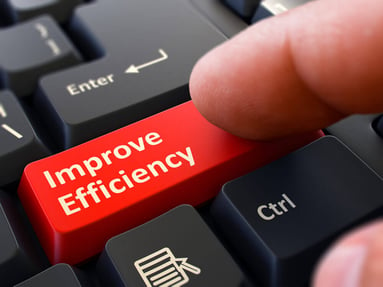5 Data-Driven Strategies for Improving Team Efficiency
In today's fast-paced world, it's crucial that teams are able to work effectively and get things done. Learn 5 ways improving team effectiveness with...
Learn 3 ways how to increase team efficiency, and effectiveness. Highly productive teams do the right things the right way.
In our daily working lives, we are continually bombarded with notifications and unproductive interruptions. On top of these distractions, we continuously see teams working on iteams which are not aligned with company priorities. In this article we will explore how leaders can make their teams more efficient and effective.
Let's start by looking into definitions of efficiency and effectiveness.
It's no surprise that many managers use the terms "team efficiency" and "team effectiveness" interchangeably, but it's important to understand the difference between the two if you want your teams to work faster and smarter. So if you've never pondered about the distinction, don't worry, you're not alone.
Peter Drucker, in his book, The Effective Executive, probably gives one the best and clearest definition for the difference of team efficiency and team effectiveness:
“Efficiency is doing things right, Effectiveness is doing the right thing.”
In the team context this means is that efficient team is doing the work the right way, and effective teams means they are working from prioritized list of high value work items.
In order for high-growth organizations to thrive, it's essential that each team is both efficient and effective. However, achieving this goal takes a deep understanding of how your teams communicate and function within the company's culture and KPIs. By identifying communication barriers, reducing out-of-hours work, improving cross-team collaboration, and providing employees with ample deep work time, you can enhance team efficiency and effectiveness.

The starting point to improve team efficiency is to identify and understand how much high impact work your teams can achieve. To gain balanced insights and make informed data-driven decision, you also need to consider your current blockers such as unproductive meetings, informational silos and poor cross-functional alignment.
You should not view team efficiency only for productivity’s sake — the more team efficiency you can foster, the faster you will achieve strategic objectives. This in turn will have a positive impact into workplace culture and encourage more healthy teamwork and cross-team collaboration which will improve your overall business performance.
If you are not convinced about why a team efficiency strategy is so important yet, let’s look at some stats from research and thought leaders:
A Qualtrics study found, perhaps unsurprisingly, that employees tend to estimate their personal productivity as being 11 percentage points higher than the actual average.
According to one study, the average employee spends 4.1 hours a day checking their email. Shockingly that means employees spend more than 50% of their available productive time reading, writing, and managing emails.
In an average workplace with 100 employees, professionals spend 17 hours a week clarifying their communications. Note the wording here—“clarifying” implies that the communication has already taken place, but additional communication was necessary to correct some flaw in the original message.
According to a study by McKinsey, companies that fully integrate social technologies see an increase in the productivity of their high-knowledge workers (i.e., managers and professionals) by up to 25 percent.
Categories of improvement include reading and answering email, searching for and gathering information, communicating and collaborating with other employees, and completing role-specific tasks.
If your entire workforce is engaged (on average), you’ll stand to outperform a disengaged competitor’s team by 202 percent. Note that the effects of having a fully engaged workforce far outweigh those of taking a single employee from “disengaged” to “engaged.”
That’s because engaged employees are more likely to collaborate, and continue making positive changes that cumulate in a better, more encouraging workplace overall.
An Atlassian study found that employees spend, on average, an hour a day in meetings. That’s nearly 30 hours a month in meetings, or over 300 hours a year. As you’ll see by the following statistics, the majority of meetings are either complete or partial wastes of time, and because meetings often involve multiple participants, the productivity costs can spiral out of control quickly.
We have defined 3 key strategies on how to improve your team efficiency, which will help you discover team productivity results quickly.

We have all sat through pointless meeting which should have been an email, or summarized in a Slack thread. This happens more often that we'd like to.
This is also evident through the previous research, "Time spent in internal meetings has been rising by 8% to 10% annually in the last decade”. This is why we highlight this as a first strategy to tackle.
Good new is, the meetings needn't be pointless. Successful internal meetings bring everyone together to check-in with one another and communicate challenges, actions and needs.
At the very least, internal meetings should keep everyone on the same page. When done well, they increase accountability, engagement, and creative problem-solving.
In turn, well-run meetings contribute to a productive, engaged workplace culture that team members actually enjoy. Successful meetings leave everyone feeling accomplished and fully aware on what has been decided.
When a team gathers to share progress and build upon it together within an agreed agenda, better business outcomes are created.
If you are planning an internal meeting, first select an outline of the concise meeting agenda. It can be confusing and disengaging if you send out a calendar invite for an internal meeting with no explanation. And if you include a lengthy explanation in the calendar invite, that can make the meeting feel unnecessarily complicated.
Every meeting should have an objective and agenda


For the purpose of this example, we have used Slack, which is now used my more than 600k organisations globally as a channel for teams whether office based, hybrid or remote to communicate and collaborate efficiently.
Slack like many other team collaboration tools are a treasure chest of team insights, by using advanced Slack collaboration analytics you quickly adopt team slack best practices to communicate and improve team efficiency.
A channel topic will let everyone know what is being worked on (ex: “Working on next quarters blog posts".)
Always share links to documents, this way channel members can easily find the most up to date document draft versions, supporting documents and final document versions. You can read 8 tips from our file usage recommendation article.
Pin the most important information to your channel so members and new colleagues can quickly find it.

Smart organizations who achieve sustainable and predictable high growth typically go hand-in-hand with high levels of cross functional collaboration and strategic alignment.
The rise of digital collaboration tools and employee communication tools has given organisations the ability to understand and improve cross-team visibility, mapping out how connected teams are influencing the business objectives and business outcomes.
These tools can serve as a centralized hub to share what you’re working on with the rest of the team and identify areas where people of different responsibilities can collaborate. By sharing a single source of truth with your team, you can boost teamwork and reduce the barriers to high-impact work so your team can be more efficient.
The blueprint for improving cross-functional collaboration determined harmonizing people, trust, and the flow of information as part of a workplace collaboration culture.
Transparency. Making sure important data can be found easily and your teams know best practices when it comes to knowledge sharing.
Empowerment. Without collaboration there would be no innovation. Give your teams the freedom within your culture to work closely together and overcome challenges quicker.
Inclusivity (with diverse teams). As the saying goes “do the same thing, get the same result”. That doesn’t necessarily mean what you are doing is producing the wrong result, but diversity of thought makes teams more resilient and versatile. Think about how you can include more diverse ways of thinking to your strategic objectives.
Tools. The right collaboration software for the right purpose. As we have already covered, emailing, unproductive meetings and poor team communication all impact team efficiency. Define your cross-functional collaboration best practices and include which tool should be used for which purpose.
Trust in metrics. Employees prioritize what they are measured against, so you should have a clear understanding of what their KPIs are and offer them a dynamic visualization of their performance. This isn’t about track keystrokes or spying on communication, it is about truly understanding the data patterns which give insights on team collaboration effectiveness and team communication efficiency.
Improving efficiency is a continuous process. It may seem overwhelming, but using an analytics tool like Flowtrace combined with team collaboration best practices can help make everyone on your team more efficient.
Every team has a variety of communication tools at their disposal, but they’re only useful if your team knows how and when to use them. Most teams are already dealing with tool overload—the average employee shuffles between 10 apps per day. Not only is that context-switching tiring, it can also be hard to find information when you need it, further down the road.
Flowtrace analytics integrates with the tools you already like Slack, Zoom, Google, Jira, GitHub, Salesforce and Hubspot to name a few.
Create your account today and benefit from more efficient team collaboration.
In today's fast-paced world, it's crucial that teams are able to work effectively and get things done. Learn 5 ways improving team effectiveness with...
Discover 6 proven ways to improve team productivity. Includes aligning goals, fostering a collaborative culture, and providing the right tools. Learn...
Explore the top collaboration tools for remote teams in 2023. Discover their unique features and learn how to choose the right one for your team.